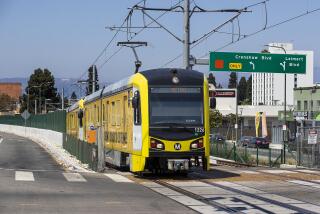High-Speed Busway the Best Way
- Share via
For the first time in years, the Los Angeles region and particularly the San Fernando Valley have an opportunity to accelerate the development of a regional transportation system that works.
Gov. Gray Davis has declared that he intends to use some of the state’s multibillion-dollar surplus for transportation capital projects throughout the state. Three of L.A.’s key transit corridors are in line to receive some of these funds: East Los Angeles, the mid-Wilshire area and the Burbank-Chandler railroad right of way in the Valley.
A consensus is forming to develop the Burbank-Chandler route as a high-speed busway, connecting the terminus of the Red Line subway at Lankershim and Chandler boulevards with Warner Center.
This nearly 15-mile line would enable West Valley commuters to reach the North Hollywood subway station in about 30 minutes, and downtown in about an hour.
When I traveled to Curitiba, Brazil, last year with Mayor Richard Riordan and Assembly Speaker-elect Bob Hertzberg (D-Sherman Oaks), we experienced its internationally recognized transportation system firsthand. Before I arrived, frankly, I was skeptical. But seeing was believing. Within minutes of riding Curitiba’s legendary high-speed bus system, I said to myself, “This could work in Los Angeles.”
Under the leadership of Gov. (and former Mayor) Jaime Lerner, Curitiba has created dedicated traffic lanes reserved for special “bi-articulated” buses (three buses connected together like a train) that carry 250 to 300 passengers at a time. These buses have the ability to electronically preempt traffic signals to ensure that they have a green light when approaching signalized intersections. They safely carry 75% of the city’s commuters at a steady 38 mph throughout the city.
The Curitiba experience easily applies to Los Angeles.
In the Valley alone, several streets and rights of way hold great potential for high-speed dedicated busways. In addition to the Burbank-Chandler line, Van Nuys Boulevard--which connects Sherman Oaks with Pacoima and the Sylmar Metrolink station--has a wider roadway than the Champs-lysees along most of its route.
It would pose little inconvenience to dedicate one north / south lane in each direction for high-speed buses. Such a line would connect the northeast Valley, one of the most transit-dependent communities in Los Angeles, with the Burbank east/west line and the communities of the southern Valley.
Similarly, Canoga Avenue, which connects Warner Center with the Chatsworth Metrolink station, has a railroad right of way that could be acquired in the future for another north/south line connecting the northwest and job-rich southwest regions of the Valley. It would also furnish an alternative for West Valley residents to connect to Universal City and downtown without ever setting foot in their cars.
Among the perennial concerns of area transportation planners is whether Los Angeles commuters can ever be enticed out of their cars and into alternative modes of travel.
The answer remains the same: If we can offer commuters a better alternative to the single-occupant car, they will use it. We have seen that with the L.A. / Long Beach Blue Line, as well as increasing ridership on the Green Line between Norwalk and El Segundo along the Century Freeway.
*
There is every reason to believe that L.A. commuters will buy a new transportation product if it offers quality, speed and reliability.
The high-speed, dedicated busway system that I have proposed for the Valley and elsewhere in the region offers such an opportunity. It is a transit system for Los Angeles--flexible, relatively inexpensive ($20 million per mile versus $300 million per mile for subway) and functional.
Above all, we could build such a system and have it running within two years; more costly alternatives are more than 15 years away.
I have discussed this proposal for the Valley with business leaders and elected officials, including Hertzberg and Riordan. There is genuine enthusiasm over its prospects.
If the governor and the Legislature see fit to fund the Valley projects--and I am hopeful that they will--we could be well on our way at last toward achieving a functioning transit system.
We have traveled a long way over the last decade toward understanding both our transit limitations and opportunities. The Metropolitan Transportation Authority nearly went bankrupt in heedless pursuit of a financially unsustainable subway project that endangered its fundamental mission of providing affordable regional public transit.
But by casting our eyes to the south, we can now clearly see that a system, which we can afford and build in our lifetime, has already been devised and put into operation in Curitiba. Los Angeles should not be too proud to adopt such common-sense proposals that can also work for our unique region.
In Curitiba last year, I asked Gov. Lerner to what he attributed his city’s success.
His answer resonates with me to this day: “Have the courage to try simple solutions.”
More to Read
Sign up for Essential California
The most important California stories and recommendations in your inbox every morning.
You may occasionally receive promotional content from the Los Angeles Times.










